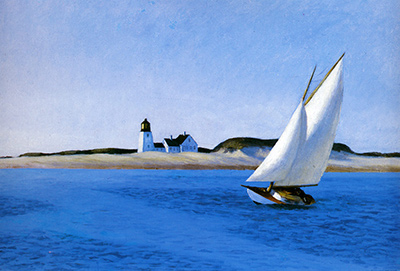Edward Hopper was an American artist and painted The Long Leg in 1935. His paintings, which are firmly planted within the genre of realism, are actually produced on canvas in a much simplified form with the clever use of light.
The Last Leg is a beautiful seascape painting that shows a simple sailboat on a still river. This image of the sailboat seems to be a recurring theme within many of Hopper's paintings, with buildings represented in the background.
The painting at first sight appears to be very simplistic but it is only after carefully considering all of the elements within the painting that the observer realises that much of the simplicity comes form the carefully chosen neutral colour pallet.
The natural colours are then contrasted with the white sail of the boat that dominated the painting.
The painting evokes in many observers a feeling of stillness, calm and solitude. It is a peaceful painting that allows for quiet contemplation and to simply 'be' in the moment.
We have the graceful movement of the sailboat, cool tonal colours and the beautiful use of natural light in the painting. All of these elements produce a sense of peace and wellbeing.
Hopper's seascape paintings were a direct contrast to those he painted of New York city life, which were mainly composed of dark and gritty colors and images.
It is believed that The Long Leg was painted when Hopper visited New England while on vacation. It was during these long vacantness that he painted many of his sailing boat themed paintings.
His seascapes generally fell into three distinct groups; those that featured lighthouses, boats and buildings. What is incredibly interesting about this particular painting, is that he chose to paint nearly the entire painting in hues of blue.




